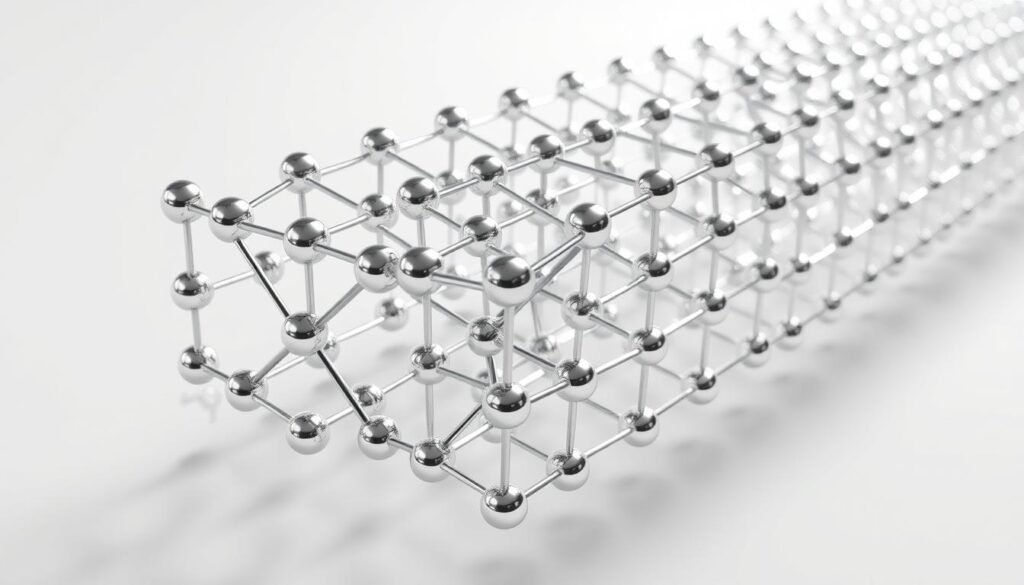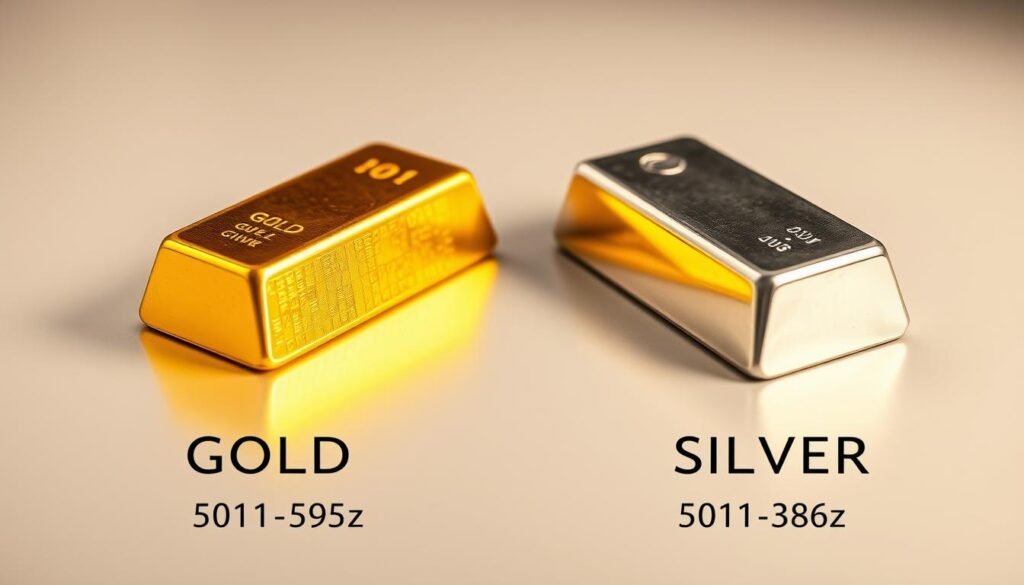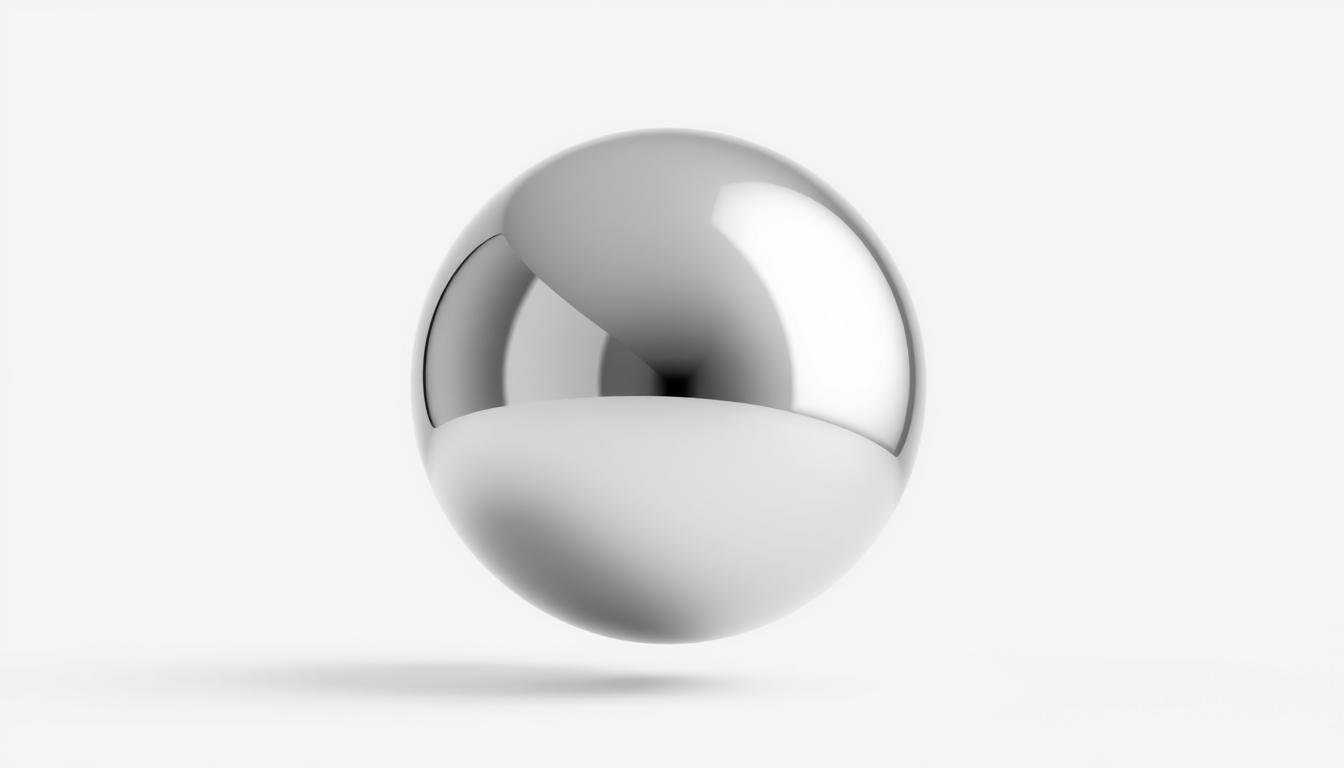The density of silver, symbolized by Ag and atomic number 47, is key to understanding its physical properties. It has a density of 10.49 grams per cubic centimeter (g/cm³). This makes silver stand out among precious metals, important for bullion and investment coins.
This density is not just a number. It helps verify silver’s authenticity and shows its importance in many industries. For example, silver’s density is higher than copper’s 8.96 g/cm³ and nickel’s 8.90 g/cm³. But it’s lower than gold’s impressive 19.32 g/cm³.
Knowing the density of silver is vital for investors and industry experts. It helps them make informed decisions.
Introduction to Silver
Silver is a highly valued precious metal with a history spanning over 6,000 years. It is known for its bright shine and special qualities. This has made silver appealing to people all over the world.
Its introduction into different cultures highlighted its worth. It was used not just for beauty but also in medicine, photography, and electronics. This shows how versatile and important silver is.
But silver is more than just a pretty metal. It’s also seen as a safe investment. People buy silver when they’re worried about the economy. This is because silver has kept its value over time.
Throughout history, silver has been used as money. It’s a key part of trade and daily life. Its value and uses make it a significant part of our world.
Understanding Density in Metals
Density is key in understanding metals. It’s the mass per unit volume. It affects the physical properties of materials. Knowing density helps engineers pick the right materials for different uses.
In metallurgy, metallic density is very important. Changes in density can show if a metal is pure or not. For instance, a denser metal might be purer, while a less dense one could have impurities.
Density in metals is more than just a number. It shows the balance of what the metal is made of, its structure, and how it works. This knowledge helps in finding new uses for metals in many fields.
Density of Silver
The definition of density is key to understanding metals like silver. Silver’s density is 10.49 grams per cubic centimeter (g/cm³). This is important for checking silver’s purity, which is vital in the bullion market.
Knowing how to measure silver density helps spot fake products. This ensures buyers get genuine items.
Definition and Measurement
Measuring silver density is simple. It involves the material’s mass and volume. Silver’s high density comes from its atomic structure and how tightly its atoms are packed.
.999 fine silver always meets the standard density. This makes it a trusted material in the industry.
Comparison to Other Metals
It’s helpful to compare silver’s density with other metals. Here’s a table showing the densities of different metals:
| Metal | Density (g/cm³) |
|---|---|
| Silver | 10.49 |
| Copper | 8.96 |
| Nickel | 8.90 |
| Gold | 19.32 |
This comparison highlights silver’s unique qualities. It shows why measuring silver density is important for both investment and industrial use. Coins like American Silver Eagles and Royal Canadian Mint Silver coins meet this standard. They are reliable investments in precious metals. For more information, visit this source.
Physical Properties of Silver
The physical properties of silver are shaped by its unique atomic structure and density. This knowledge shows why silver is special in many fields, like jewelry and industrial uses.
Atomic Structure and Density
The silver atomic structure has a special electron setup: [Kr] 4d10 5s1. This setup helps silver form a strong, cubic crystal shape. This shape is key to its high density.
Its atomic volume is 10.3 cm³/mol. This means silver can hold its shape well in many places.
Softness and Ductility
Silver is soft and can be shaped easily. It doesn’t break when made into wires or sheets. This is because of how its atoms are arranged.
Its softness and ability to bend make it great for many uses. This includes electronics and decorative arts. Its high density adds to its value in these areas.

Significance of Silver’s Density
The density of silver is key in its uses and value. It affects how well it works in different fields and its worth in the market.
Application in Industry and Investment
Silver’s density is about 10.49 g/cm³. This makes it vital in electronics and energy. Its high density means it conducts electricity and heat well.
This is why silver is used in phones and solar panels. It boosts their performance and efficiency.
For investors, knowing silver’s density is important. It helps spot real silver coins and bullion. This is true for things like Individual Retirement Accounts. Silver’s density shows it’s genuine, making it a smart choice for investors.
| Property | Value |
|---|---|
| Density | 10.49 g/cm³ |
| Heat Conductivity | High |
| Electrical Conductivity | Exceptional |
| Standard Uses | Electronics, Jewelry, Investment |
Every aspect highlights silver’s value in both use and investment. For more on the *density of silver*, check out this link.
Comparison of Silver’s Density with Other Precious Metals
The density of metals is key to their physical traits and uses. Silver’s density of 10.49 g/cm³ is quite different from gold’s. This difference affects their weight and value in investments.
Gold versus Silver Density
Gold has a density of 19.32 g/cm³, making it heavier than silver. This weight difference is important when comparing them. Investors look at this when deciding which metal to invest in.
Copper and Nickel Comparison
Copper and nickel offer more insights into metal density. Copper is about 8.96 g/cm³, and nickel is around 8.90 g/cm³. These numbers help us see how silver and gold stand out in different markets.
| Metal | Density (g/cm³) |
|---|---|
| Gold | 19.32 |
| Silver | 10.49 |
| Copper | 8.96 |
| Nichol | 8.90 |

Industrial Applications of Silver
Silver is key in many industrial uses, mainly in electronics. Its unique properties, like top-notch conductivity, make it ideal for parts needing reliable electrical work. This is true for everything from smartphones to high-end computers, where silver ensures devices work well and last long.
Electronics and Conductivity
Silver is the best metal for carrying electricity. Its high conductivity is essential for making electrical contacts and paths in gadgets. It’s used in everything from everyday electronics to space systems, where it’s needed to perform consistently.
Reflectivity in Solar Panels
Silver also helps in renewable energy, like solar panels. It boosts reflectivity and conductivity, helping panels catch more sunlight. This makes solar cells more efficient and effective, supporting green energy efforts.
| Application | Property Leveraged | Industry Impact |
|---|---|---|
| Electrical Contacts | High conductivity | Increased device efficiency and reliability |
| Circuit Paths | Enhanced electrical transmission | Improved performance in devices |
| Solar Panels | Reflectivity and conductivity | Boosts energy efficiency |
| Thermal Management Systems | Effective heat conduction | Optimizes device performance |
Historical Importance of Silver
Silver has been key in shaping human culture and civilization. Its unique look and properties made it popular for both trade and art. It shows up in many parts of life, like ritual items and fancy jewelry, showing what societies valued in the past.
Silver in Human Culture
Silver artifacts have been found in many cultures, showing its beauty and usefulness. In old times, silver was linked to gods and used in special objects. These items give us a peek into the beliefs and ways of life of ancient societies, highlighting silver’s role as a sign of wealth and purity.
Use in Currency and Investment
The shift of silver into money was a big step in economic history. As one of the first metals used as currency, silver helped trade and commerce grow. Now, it’s seen as a safe investment against inflation and economic troubles. Its value to collectors and investors shows silver’s lasting impact on human life.

Silver Density for Popular Silver Coins
Knowing the density of silver coins is key for both collectors and investors. Coins like the American Silver Eagle and the Canadian Maple Leaf are made of .999 fine silver. This means they have a density of 10.49 grams per cubic centimeter.
This density is important. It shows that the coins are real and of high quality. It proves the value of the silver in these coins.
Common Coins and Their Density
Some silver coins are more well-known than others. Here are a few:
- American Silver Eagles
- Mexican Silver Libertads
- Royal Canadian Mint silver coins
- Perth Mint Australian silver coins
These coins all have the same density. This shows they are pure and heavy. Knowing this helps buyers understand their worth. For more info, check out this page.
Implications for Collectors and Investors
The density of silver coins affects their value. Coins with more silver are worth more. Knowing about silver coins density helps buyers make smart choices.
It also helps them see how much they can sell their coins for later. Recognizing good coins helps the market grow and stay stable.
Conclusion
Silver’s density is key in many fields, like investment and tech. It has a density of 10.49 g/cm³, making it as valuable as popular silver coins. This shows silver is a trusted asset, proving its worth to collectors and investors.
Its unique traits, like being great at conducting electricity and reflecting light, make it essential in today’s tech and solar fields. The density of silver affects its use and value in these areas. This highlights the need for professionals to understand its properties well.
Knowing about silver’s importance in different areas is vital. For those interested in its market value or uses, more info on silver density is available here. A deep understanding helps investors and industry experts make better choices.
